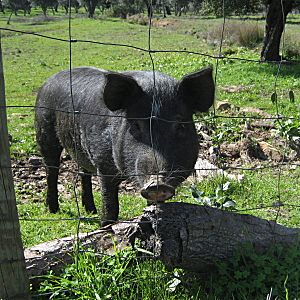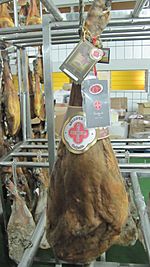Black Iberian pig facts for kids

|
|
| Country of origin | Iberian Peninsula |
|---|---|
| Traits | |
|
|

The Iberian pig is a special kind of domestic pig. It comes from the Iberian Peninsula, which is where Spain and Portugal are located. These pigs have been around for a very long time, possibly since the Neolithic age when people first started taming animals. Today, you can find them in herds mainly in the central and southern parts of Spain and Portugal.
Contents
About the Iberian Pig
The most common idea is that the first pigs arrived in the Iberian Peninsula with the Phoenicians. They were traders from the eastern Mediterranean coast. These pigs then mixed with wild boars that were already there. This mixing created the ancestors of the Iberian pigs we see today.
Why They Are Special
Iberian pigs are unique because they live in a special ecosystem called the Mediterranean forest. This area is rich in natural foods, especially acorns. These acorns come from different types of oak trees. The Iberian pig helps keep this natural environment healthy. It is one of the few farm animals that still lives in a natural, open setting.
Their Numbers Over Time
The number of Iberian pigs dropped a lot after 1960. This was due to diseases like African swine fever. Also, people wanted less animal fats back then. However, in recent years, more people want high-quality meat and cured products. This has led to an increase in Iberian pig farming again.
What Makes Their Meat Unique?
Iberian pigs love to eat and can get quite plump. They have a special ability to store fat within their muscles. This fat creates a "marbling" effect in the meat. When combined with their traditional diet of acorns, it gives their ham a very special taste. Meat from Iberian pigs is different from meat from pigs raised on big industrial farms. It is known as a very high-quality and valuable product.
Life in the Dehesa
Iberian pigs can be red or dark in color. Black pigs often have little or no hair and a lean body. This is why they are sometimes called pata negra, meaning "black hoof."
The Dehesa Ecosystem
In traditional farming, these pigs roam freely in open oak forests. These forests are called dehesa in Spain and montado in Portugal. Because they are always moving, they burn more calories than pigs kept in pens. This helps them develop the fine bones that are typical of jamón ibérico.
A single pig needs at least one hectare (about 2.5 acres) of healthy dehesa to live. The oak trees in these areas can be hundreds of years old. This makes it hard to regrow lost dehesa areas.
Acorns and Their Importance
True dehesa is a very diverse habitat. It has four different types of oak trees. These trees are very important for producing top-quality ham. Most of the acorns come from the holm oak (Quercus rotundifolia) from November to February. But other oaks extend the acorn season. The Pyrenean oak (Quercus pyrenaica) and Portuguese or gall oak (Quercus lusitanica) provide acorns earlier. The late cork oak (Quercus suber) season extends it almost to April. This long acorn season is key for the pigs' diet.
See also
 In Spanish: Cerdo ibérico para niños
In Spanish: Cerdo ibérico para niños


